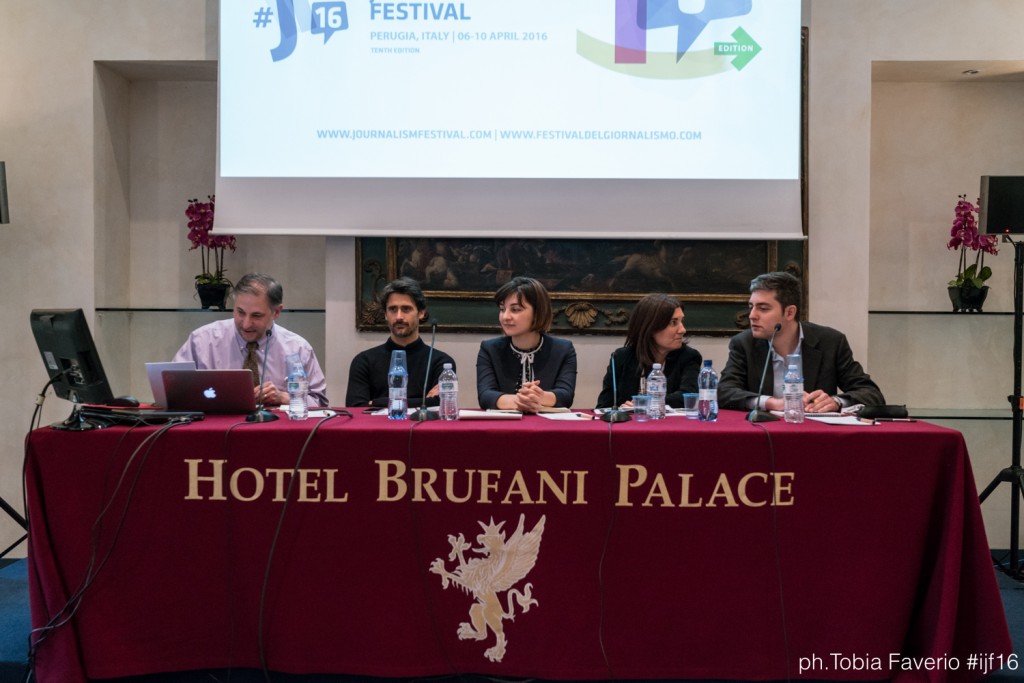
What is the status of fact-checking and what are the numbers about the movement that it has generated?
On 8 April, 2016 Mark Stencel, Co-director at Duke Reporters’ Lab, monitored a panel at the International Journalism Festival to answer these questions: alongside him were Julien Pain, Editor-in-Chief at Observers on France 24, Itziar Bernaola, Deputy Director at El Objetivo, Giovanni Zagni, Senior Analyst from Pagella Politica, and Mevan Babakar from Full Fact. With over 100 fact-checking projects launched around the world, data journalism is emerging as a strong counterforce against false claims made either on the web, on print or on television.
The conversation started by looking at the state of fact-checking at the present time. Stencel pointed out how different it can be from country to country. In fact, where in the States 90% of fact-checking is done by media organisations, in the rest of the world figures are much smaller, with only 50% of the media actively engaging with data journalism, which is confined to the print field.
“This is no longer for specialists in small rooms and geeks. It is something every journalist should learn to do properly,” said France 24’s Julien Pain. “Checking information available to citizens is extremely important in a democratic society.”
With social media content on the rise as a primary source of information, newsrooms have to learn how to check content as fast as they can, an asset that is essential for the team at Observers. “Manipulated stories are coming up on social media and we have to do something about this,” said Pain.
“You need specific tools to fact-check the reliability of your source. It’s not enough to be a senior field reporter anymore,” he continued.
Ever since data journalism has come into practice, it has always been confined to newspapers and never associated with broadcasters. As the demand for more accurate information grows and new media spread among audiences all around the world, television outlets have started to take on the fact-checking process and experiment with it.
A successful example is El Objetivo by Spanish TV La Sexta. “We love data journalism and we wanted to do data journalism on television,” said Deputy Editor Bernaola. The programme holds national politicians to account by collecting claims made overtime and analysing possible inaccuracies.
Last summer only, El Objetivo reached an average audience of 2.5 viewers, proving the successful ties between data journalism and televised media.
The secret lays in the way false claims are exposed: “We try to make fact-checking entertaining,” said Bernaola. “Many people want more information and in TV you have to turn very complex things into very simple things.”
Together with breaking into broadcast, fact-checking has also proven itself to be a universal tool for cross country collaborations.
Giovanni Zagni from Pagella Politica explored the Factcheckathon projects, a series of initiatives where different countries worked together for the sake of accuracy: among the examples brought up, the G20 in Australia in November 2014 and in Turkey in 2015, as well as how EU countries portrayed one another in the handling of the refugee crisis.
Zagni introduced the International Fact Checking Network, launched in 2015 and aimed at the study of ethics and funding using turbo-power technologies to fact-check data with an international angle.
In fact, in an era where journalists all around the world are losing their credibility in the eyes of the public, the need for a cross country organisation is stronger than ever.
“Trust in journalists is declining. Fact-checking can help us regain that trust,” said Mevan Babakar. She explained how the strategy Full Fact uses is spread over three steps: finding the claim, checking the claim and making content about the claim.
“The faster you go through this cycle, the quicker you can provide information that can help the audience make up their mind,” she said.
In all scenarios, be it broadcast or online, preparation is key towards targeting fake information. All members of the panel agreed that accuracy has to come before immediacy, with journalists and fact-checkers always keeping their eyes open to spot possible “pseudo-scientific” claims.